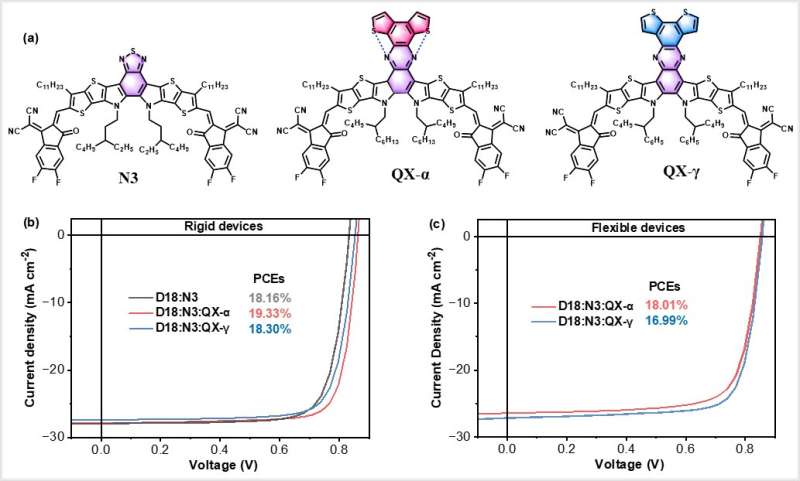

| Date | 21st, Jun 2023 |
|---|
 The molecular structures of N3, QX-α, and QX-γ (a); J-V curves of the rigid (b) and flexible (c) organic solar cells. Credit: NIMTE
The molecular structures of N3, QX-α, and QX-γ (a); J-V curves of the rigid (b) and flexible (c) organic solar cells. Credit: NIMTE
A research group led by Prof. Ge Ziyi at the Ningbo Institute of Materials Technology and Engineering (NIMTE) of the Chinese Academy of Sciences (CAS) has developed two isomeric non-fullerene acceptors and doped them into the D18:N3-based binary organic solar cells (OSCs) as a third component, resulting in highly efficient rigid and flexible ternary OSCs with power conversion efficiency (PCE) of 19.3% and 18.0%, respectively.
This work was published in Energy & Environmental Science.
Due to the advantages of flexibility, portability, and transparency, OSCs hold a promising prospect in the field of green energy technology. Currently, the ternary strategy is one of the efficient methods to improve the performance of OSCs. The strategy of isomerization has been considered as an effective way to improve the efficiency of OSCs by optimizing the molecular structures. Previous studies on isomer effects have focused on binary OSCs, with only a few works on ternary OSCs.
To address this issue, the researchers synthesized two large π-conjugated isomers of Y6 derivatives, i.e., QX-α and QX-γ, with the same molecular formula but different orientations of their fused thiophene-rings.
The two isomers were each introduced as the third component in the D18:N3-based binary devices. Thus, the influence of isomers in non-fullerene guest acceptors on their photovoltaic properties was investigated in detail.
Compared with QX-γ, QX-α has a stronger dipole moment, a more ordered stacking, and a higher surface energy due to the S···N non-covalent interactions. The developed D18:N3:QX-α-based ternary OSCs achieved an excellent PCE of 19.33%, while the D18:N3:QX-γ-based device only exhibited a PCE of 18.30%, which is comparable to the standard binary device with a PCE of 18.16%.
In addition, the flexible device based on the D18:N3:QX-α achieved an outstanding PCE of 18.01%, which is the highest value reported to date for flexible OSCs.
After being stored at 85 ℃ for 476 hours in an N2-filled glove box, the D18:N3:QX-α-based ternary device showed a significant increase in efficiency retention from 49% to 87%, indicating an excellent thermal stability.
This ternary device retained over 97% of the initial PCE at room temperature for over 2,200 hours. Moreover, the extrapolated T80 lifetime of the device reached 17,000 hours, showing a broad prospect for commercial application.
The isomerization strategy has provided a promising and effective route to develop non-fullerene guest acceptors for stable high-efficiency ternary OSCs.
More information: Zhengyu Chen et al, Isomerization Strategy on Non-fullerene Guest Acceptor Enables Stable Organic Solar Cells over 19% Efficiency, Energy & Environmental Science (2023). DOI: 10.1039/D3EE01164J
Citation: Isomerization strategy on non-fullerene guest acceptor enables stable and efficient organic solar cells (2023, June 21) retrieved 9 July 2023 from https://techxplore.com/news/2023-06-isomerization-strategy-non-fullerene-guest-acceptor.html
This document is subject to copyright. Apart from any fair dealing for the purpose of private study or research, no part may be reproduced without the written permission. The content is provided for information purposes only.
